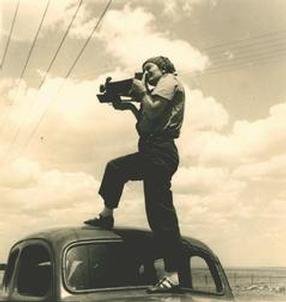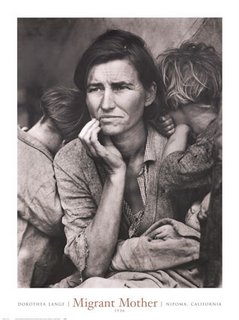


"You put your camera around your neck along with putting on your shoes, and there it is, an appendage of the body that shares your life with you. The camera is an instrument that teaches people how to see without a camera." - Dorothea Lange
Born in Hoboken, New Jersey, in 1895, Dorothea was the first child of Joan and Henry Nutzhorn, both second generation German-Americans; her brother, Martin, was born in 1901. Though her first seven years were likely happy, the following 12 were not. At age seven, Dorothea contracted polio, leaving her with a lifelong limp in her right leg; at age 12, her father, a successful lawyer, abandoned his family, never to be heard from again.

Migrant Mother, 1936
"I saw and approached the hungry and desperate mother, as if drawn by a magnet. I do not remember how I explained my presence or my camera to her, but I do remember she asked me no questions. I made five exposures, working closer and closer from the same direction. I did not ask her name or her history. She told me her age, that she was thirty-two. She said that they had been living on frozen vegetables from the surrounding fields, and birds that the children killed. She had just sold the tires from her car to buy food. There she sat in that lean- to tent with her children huddled around her, and seemed to know that my pictures might help her, and so she helped me. There was a sort of equality about it." ~ Dorothea Lange (From: Popular Photography, Feb. 1960).
Drought Refugees Hoping for Cotton Work, Blythe, Ca 1936
The insightful and compassionate photographs of Dorothea Lange has exerted a profound influence on the development of modern documentary photography. Lange's concern for people, her appreciation of the ordinary, and the striking empathy she showed for her subjects make her unique among photographers of her day.
Critics and curators, family and friends agree that it was the heart of Dorothea Lange that guided the focus of her camera lens and composition of images. Whether viewing a single image or the thousands that comprise a lifetime's work, one sees that Lange called upon the sheer power of her considerable will to force the medium of photography to obey and respond to the world that surrounded her. Whether this world was the San Joaquin Valley or the Mississippi Delta, the small communities of America's farm belt or countryside of Ireland; the villages of Southeast Asia or the streets of San Francisco, she saw people that needed --- and deserved --- attention. Dorothea Lange responded by documenting their existence for others to see. This she did because she believed passionately that those who were pushed to the margins, whose existence had no color, needed to be heard, as well as seen. This commitment to the colorless and voiceless came from within. Dorothea Lange's public life as a "Photographer of the People".
On October 11, 1965 Lange died in San Francisco at the age of seventy.
Recommended Reading List:
An American Exodus: A Record of Human Erosion by Dorothea Lange, Paul Schuster Taylor, Paul Taylor
Impounded: Dorothea Lange and the Censored Images of Japanese American Interment by Dorothea Lange
Photographing the 2nd Gold Rush: Dorothea Lange and the East Bay at War, 1941, by Dorothea Lange, Charles Wollenberg
N Posted by Rain at 5/20/2006 12:59:00 AM
![]()
![]()





